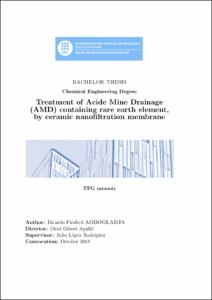Mostra el registre d'ítem simple
Treatment of Acid Mine Drainage (AMD) containing rare earth element, by ceramic nanofiltration membranes
| dc.contributor.author | Agbogladja, Ricardo Pirabed Alononme |
| dc.contributor.other | Universitat Politècnica de Catalunya. Departament d'Enginyeria Química |
| dc.date.accessioned | 2019-09-17T13:07:50Z |
| dc.date.available | 2019-09-17T13:07:50Z |
| dc.date.issued | 2018-10-24 |
| dc.identifier.uri | http://hdl.handle.net/2117/168319 |
| dc.description.abstract | Per poder reciclar les aigues provenent dels procesos mineres, es necesita previament un procés de filtració. L'objectiu es separa o baixar la concentració d'alguns soluts disolts. Per exemple ions de sulfats, ferrics, sòdic. Durant el treball desarollarem totes les etapes necessàries per dur a terme la separació. I finalment un model de tot el procés. -CG2,CG3 |
| dc.description.abstract | Acid Mine Drainage (AMD) often emerges naturally, however the extraction activities in the mine industry have recently increased the influence of different chemical, physical and biological factors related to its production. Hence, the activity of humans is again the main protagonist if the intensification of AMD negative impacts on water sources, plants and animals. Generally, AMD is produced by the oxidative dissolution of sulphide minerals producing a drainage with low pH and high concentration in sulphate, heavy metals such as (iron, copper, zinc, lead) and others rare earth elements (REE) like (lanthanum, ytterbium and neodymium). Within this context, this project aims to extend the application of nanofiltration (NF) on AMD treatment using ceramic membranes. In this case AMD treatment can be understood as a procedure aims to reduce the amount of sulphate, aluminium, iron and REE among others elements present in an AMD solution by NF technique. Primarily the performance of NF oxide titanium [TiO2] membrane was used to study the rejection of dominant salts, aluminium and iron sulphate, at pH (1 and 1.5) and different concentrations with a synthetic solution that reproduces AMD solutions. Others traces ions such as zinc, copper, calcium and REE were also combined into that solution to study their rejection under the influence of the dominant salts previously introduced. The experiments were performed in a lab-scale installation, where, the concentrations vary from 300 to 1900 ppm for aluminium and from 500 to 2000 ppm for iron on one hand. On the other, REE concentrations were maintained constant at a nominal concentration of 10 ppm. Consecutively, the experimental data were fitted by means of the solution-diffusion-film-model (SDFM) in order to calculate the membrane permeabilities to each ion. This document, firstly starts with the introduction that explores all the basic concepts to understand the mechanics of NF. Secondly, the objectives and the methodology explain the steps to achieve the objectives proposed. Finally the results analysis, cost evaluation and the environmental impact sections pretend to give strength to all the key aspects investigated. |
| dc.language.iso | eng |
| dc.publisher | Universitat Politècnica de Catalunya |
| dc.rights | Attribution 3.0 Spain |
| dc.rights.uri | http://creativecommons.org/licenses/by/3.0/es/ |
| dc.subject | Àrees temàtiques de la UPC::Enginyeria química::Química del medi ambient::Química de l'aigua |
| dc.subject.lcsh | Membranes (Technology) |
| dc.subject.lcsh | Nanofiltration |
| dc.subject.lcsh | Sewage -- Purification |
| dc.subject.other | Nanofiltration |
| dc.subject.other | Ceramic membrane |
| dc.subject.other | Water treatment |
| dc.subject.other | Rare Earth Element (REE) |
| dc.subject.other | Acide Mine Drainage (AMD) |
| dc.subject.other | Filtration |
| dc.subject.other | depuració |
| dc.subject.other | aigües àcides de mines |
| dc.subject.other | purificació |
| dc.title | Treatment of Acid Mine Drainage (AMD) containing rare earth element, by ceramic nanofiltration membranes |
| dc.type | Bachelor thesis |
| dc.subject.lemac | Mines -- Aspectes ambientals |
| dc.subject.lemac | Membranes (Tecnologia) |
| dc.subject.lemac | Nanofiltració |
| dc.subject.lemac | Aigües residuals -- Depuració |
| dc.subject.lemac | Aigües àcides -- Depuració |
| dc.identifier.slug | PRISMA-133532 |
| dc.rights.access | Open Access |
| dc.date.updated | 2019-05-30T07:51:29Z |
| dc.audience.educationlevel | Grau |
| dc.audience.mediator | Escola d'Enginyeria de Barcelona Est |
| dc.audience.degree | GRAU EN ENGINYERIA QUÍMICA (Pla 2009) |


